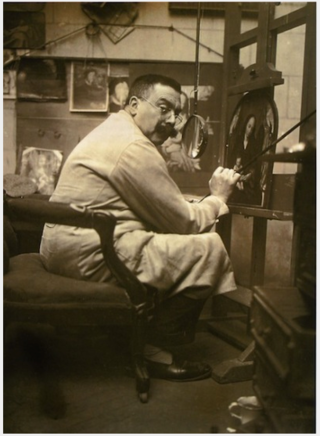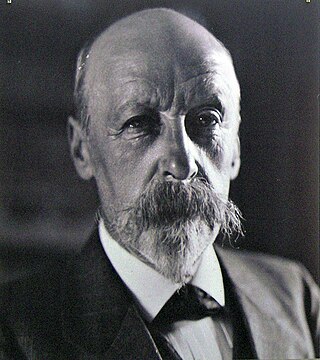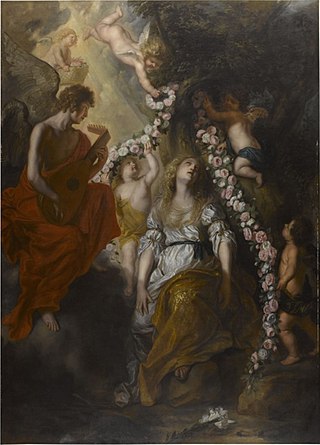
Sir Anthony van Dyck was a Flemish Baroque artist who became the leading court painter in England after success in the Spanish Netherlands and Italy.

Adriaen Isenbrandt or Adriaen Ysenbrandt was a painter in Bruges, in the final years of Early Netherlandish painting, and the first of the Dutch and Flemish Renaissance painting of the Northern Renaissance. Documentary evidence suggests he was a significant and successful artist of his period, even though no specific works by his hand are clearly documented. Art historians have conjectured that he operated a large workshop specializing in religious subjects and devotional paintings, which were executed in a conservative style in the tradition of the Early Netherlandish painting of the previous century. By his time, the new booming economy of Antwerp had made this the centre of painting in the Low Countries, but the previous centre of Bruges retained considerable prestige.

Josephus Maria Van der Veken was a Belgian art restorer, copyist, and art forger who mastered the art of reproducing the works of early Netherlandish painters.

Théophile "Théo" van Rysselberghe was a Belgian neo-impressionist painter, who played a pivotal role in the European art scene at the turn of the twentieth century.

Hugo van der Goes was one of the most significant and original Flemish painters of the late 15th century. Van der Goes was an important painter of altarpieces as well as portraits. He introduced important innovations in painting through his monumental style, use of a specific colour range and individualistic manner of portraiture. From 1483 onwards, the presence of his masterpiece, the Portinari Triptych, in Florence played a role in the development of realism and the use of colour in Italian Renaissance art.

Alfred Émile Léopold Stevens was a Belgian painter, known for his paintings of elegant modern women. In their realistic style and careful finish, his works reveal the influence of 17th-century Dutch genre painting. After gaining attention early in his career with a social realist painting depicting the plight of poor vagrants, he achieved great critical and popular success with his scenes of upper-middle class Parisian life.

Florent Willems or Florent Willems van Edeghem was a Belgian painter and art restorer. He was successful with his genre scenes depicting a few figures in an interior executed in the style of the 17th century Flemish and Dutch Baroque. He was particularly praised for his ability to render realistically the materials of the clothes of his figures which earned him the nickname of the 'modern Ter Borch'.

Emile Claus was a Belgian painter.

The Royal Museum of Fine Arts Antwerp is a museum in Antwerp, Belgium, founded in 1810, that houses a collection of paintings, sculptures and drawings from the fourteenth to the twentieth centuries. This collection is representative of the artistic production and the taste of art enthusiasts in Antwerp, Belgium and the Northern and Southern Netherlands since the 15th century.

James Sidney Edouard, Baron Ensor was a Belgian painter and printmaker, an important influence on expressionism and surrealism who lived in Ostend for most of his life. He was associated with the artistic group Les XX.

Nicolas Régnier (1591–1667), known in Italy as Niccolò Renieri, was a painter, art dealer and art collector from the County of Hainaut, a French-speaking part of the Spanish Netherlands. He is often referred to as a Flemish artist because this term was often used to designate people from the Spanish Netherlands. After training in Antwerp, he was active in Italy where he was part of the international Caravaggesque movement. His subjects include genre scenes with card players, fortune tellers, soldiers and concerts, religious scenes, saints, mythological and allegorical scenes, and portraits. He also painted a few scenes with carnivals.

The Museum of Fine Arts an art museum in Ghent, Belgium, is situated at the East side of the Citadelpark.

Theodoor Boeyermans, Theodor Boeyermans or Theodor Boeijermans was a Flemish painter active in Antwerp who painted Baroque history paintings and group portraits informed by the tradition of Peter Paul Rubens and Anthony van Dyck.

The Aix Annunciation is a painting attributed to the Barthélemy d'Eyck or the so-called Master of the Annunciation of Aix-en-Provence. Executed in 1443-1445, it was originally placed in the Cathédrale Saint-Sauveur, Aix-en-Provence, southern France. Now it is divided between the Église de la Madeleine in the same city, the Museum Boijmans Van Beuningen at Rotterdam, the Rijksmuseum of Amsterdam, while the right panel is in the Royal Museum of Fine Arts of Belgium in Brussels. Side panels are painted on both sides, showing Christ on the right and Mary Magdalene on the left ; together they used to form a Noli me tangere scene when the triptych was folded shut.

The Exposition des primitifs flamands à Bruges was an art exhibition of paintings by the so-called Flemish Primitives held in the Provinciaal Hof in Bruges between 15 June and 5 October 1902.

Adolphe Pierre Sunaert, Adolphe Sunaert or Adolf Sunaert was a Belgian painter, printmaker, teacher and author. He played a role in the organization and conservation of the art collections of the city of Ghent.

Joseph Stevens, birth name Edouard Joseph Léopold Stevens was a Belgian animalier painter and engraver. He is mainly known for his paintings with dogs as the principal subject. This included dog portraits, dogs interacting among themselves or with their masters and dog markets. From depicting sentimental scenes in a Romanticist manner his art developed towards a more Realist rendering of dogs living on the street or working for travelling entertainers. He won the admiration of the French realist painter Courbet for these efforts. He was a pioneer of Realism in Belgian art. He further painted horses and singeries, scenes with monkeys engaging in human activities. A few marines by his hand are also known.

The Parisian Sphinx is an oil-on-canvas painting by Belgian painter Alfred Stevens. Painted between 1875 and 1877, it depicts a dreamy young woman gently supporting her head with her hand. The painting is part of the permanent collection of the Royal Museum of Fine Arts in Antwerp. The Parisian Sphinx shows the influence of Vermeer and the other Netherlandish old masters on Stevens, and testifies to the Symbolist influence in the latter's day. It incorporates a harmonious juxtaposition of superficial Dutch realism with the spreading Symbolist manner, as opposed to the bottom-up, pluralistic symbolism of the declining Romanticism.

Camille Lemonnier in the Artist's Studio is an oil on canvas painting by Belgian painter Alfred Stevens. The portrait was for many years part of a private collection in Paris, but in 2015 it was purchased by the Heritage Found, and is currently housed at the Royal Museums of Fine Arts in Brussels.

Portrait of Marguerite van Mons is an oil-on-canvas painting by Belgian painter Théo van Rysselberghe. The girl portrayed is ten-year-old Marguerite van Mons, depicted shortly after the death of her mother. Théo van Rysselberghe was friends with Emile van Mons, a lawyer and well-known art lover, and painted his daughter Marguerite in June 1886. He had previously painted a portrait of her sister Camille which is now part of the collection of the Niedersächsisches Landesmuseum in Hanover.





















